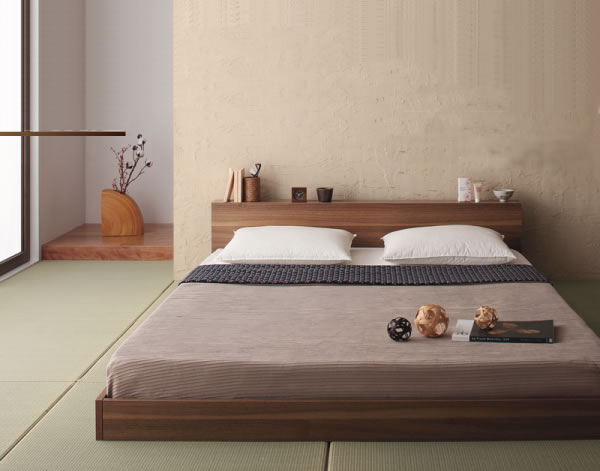5 questions about living in a Japanese Tatami Room

- What is good about tatami?
・The effect of soft rush
Soft rush, the raw material for tatami mats, contains various aromatic components. What is good about tatami is that you can expect a high relaxing effect.
・Soundproof effects
Tatami, which is made from soft rush, contains air between each strand and has the role of improving sound insulation performance.
The footsteps are less likely to resonate than flooring because the air contained in the tatami mats absorbs the sound and softens the impact.
・High heat insulation
Also the air contained in tatami has high heat insulation performance. Since it can take in a lot of air with low thermal conductivity, it can block the cold air coming up from under the floor.
Furthermore, it also has the function of absorbing and releasing moisture in the air.
During the rainy season, the tatami mats absorb moisture, which maintains low humidity in the room, and during the dry winter, it releases moisture to prevent the humidity from dropping.
2. Can we put beds on tatami?

you can put your beds on tatami mats but you need to be careful of denting them.
・Lay a carpet on the tatami mat
Carpeting on top of tatami not only has the advantage of protecting the surface of tatami, but also improves the feel and comfort of tatami and reduces the amount of house dust. It also allows you to redecorate your room like a Western room.
・Rubber piece and joint mat
Attach a piece of rubber that is about 1 cm thick and has a larger area than the legs, and lay a joint mat under the legs to prevent it from denting.
・Bed without legs.
By using a legless bed, you can distribute the load and reduce the damage to the tatami.
※It is important to move the bed and carpet away from the tatami to regularly air out the space between them.
3. How can we change tatami mats?
・Ask the reform agency
・Bring them to a hardware store
※If you live in the UR apartment, please contact the management office beforehand and follow their instruction.
There are three ways of making tatami clean.
・“Turn over(Ura-gaeshi)”

Ura-gaeshi means turning the old tatami mat upside down and using it with the clean side facing up.
It is recommended to turn it over 2-3 years after replacing the tatami mats.
Since it also involves peeling off the tatami mats and removing the threads that are fixed to the tatami floor, the side tatami mats will have to be replaced with new ones.
Just by turning it over, you can smell the soft rush again.
・”Replacing only surface(Omote-gae)”

Omote-gae is to replace the goza-shaped tatami mats woven with rush and hemp thread with new ones.
The tatami mat is made by weaving heartwood and soft rush, but if this heartwood is still usable, you can regain the original quality by simply replacing the soft rush.
If the tatami mats are no longer glossy, or if it has been 2 to 5 years since you changed them, it is recommended to replace them.
・“Replacing Tatami(Shincho)”
If the tatami floor, which is the core material of tatami mats, is worn out and makes a creaking noise when you step on it, or if the floor surface becomes soft and feels like it is floating, it means the surface of the tatami mat is hurt. Of course, the heartwood itself is damaged, so it will be renewed.
Generally, it should be replaced every 10 to 15 years, but if you continue to use tatami mats carefully, you may be able to continue using it for 30 years or more.
4. How much does it cost to repair?
The turnover(Ura-gaeshi) price is about 2,000 to 5,000 yen per tatami mat.
The market price for changing tatami mats is about 5,000 to 15,000 yen per tatami mat.
The market price for new tatami mats is about 10,000 to 25,000 yen per tatami mat.
5. Is there any caution in using tatami?
If you lay a carpet on the tatami mat, dust will be collected easily and mites will easily appear.
On sunny days, open the windows frequently to improve ventilation. Leaving the room closed will increase the humidity and make the tatami mats more susceptible to mold and mites.
It is forbidden to wipe a tatami mat with a wet rag. Also, avoid overusing the humidifier. Moisture on tatami is a powerful enemy.
In addition, be sure to clean it frequently so that you can use it for a long time.
6. To wrap everything up
Tatami has a relaxing, soundproofing, and high heat insulation effect due to the rushes.
Tatami can be used in a variety of ways: you can lay out a futon to sleep on, or you can place a bed on it. When placing a bed, it is important to lay a carpet over the tatami, cover the legs of the bed with piece and joint mat, or use a bed without legs.
If your tatami is getting dirty, there are three ways to clean it; 1) turnover (ura-gaeshi); 2) replacing the surface (omote-gae); 3) replacing the tatami.
The price varies depending on the method and ranges from 2,000 yen to 25,000 yen.
When you use tatami, it is important to pay attention to moisture in order to prevent mold and mites.

